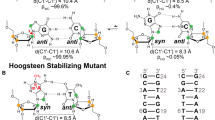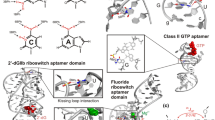Abstract
The structure of the 13C,15N-labeled d(GCGAAGC) hairpin, as determined by NMR spectroscopy and refined using molecular dynamics with NOE-derived distances, torsion angles, and residual dipolar couplings (RDCs), is presented. Although the studied molecule is of small size, it is demonstrated that the incorporation of diminutive RDCs can significantly improve local structure determination of regions undefined by the conventional restraints. Very good correlation between the experimental and back-calculated small one- and two-bond 1H-13C, 1H-15N, 13C-13C and 13C-15N coupling constants has been attained. The final structures clearly show typical features of the miniloop architecture. The structure is discussed in context of the extraordinary stability of the d(GCGAAGC) hairpin, which originates from a complex interplay between the aromatic base stacking and hydrogen bonding interactions.
Similar content being viewed by others
Author information
Authors and Affiliations
Corresponding author
Electronic Supplementary Material
Rights and permissions
About this article
Cite this article
Padrta, P., Štefl, R., Králík, L. et al. Refinement of d(GCGAAGC) hairpin structure using one- and two-bond residual dipolar couplings. J Biomol NMR 24, 1–14 (2002). https://doi.org/10.1023/A:1020632900961
Issue Date:
DOI: https://doi.org/10.1023/A:1020632900961




